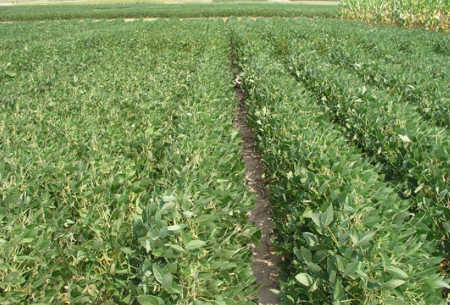Soybean planted in Missouri has been greatly delayed because of record breaking wet weather in May. Average yield for soybean planted in the third week of June is at least 25% less than when soybean is planted in early May. There are several management practices that may add a little extra yield to late planted soybean. Yield results from captured sunlight. Late planted soybean is at a disadvantage because daylight periods are shorter during seed filling, the length of the seed-filling period is shorter, and plants are often smaller with fewer nodes. So, managing soybean to increase light capture may improve yield potential.

Rows of soybeans spaced at 15 inches on left and 30 inches on right
Planting in narrow rows allows plants to capture available sunlight sooner in the shortened growing season. I have a limited data set in which I tested both row width and planting date. This experiment was conducted for two years in central Missouri. Yield response to 15-inch rows compared to 30-inch row was 8% when soybean was planted in mid-May, but 14% when planted in the third week of June. For full season soybean we have found no difference for soybean yield between 15-inch row spacing and drilled soybean in 7.5-inch rows. However, as planting date gets pushed later into June, one might consider using a drill.
Late planted soybean plants produce fewer main stem nodes and smaller or fewer branches. Nodes are important because that is where pods form, so yield can be related to the number of nodes. If plants produce fewer nodes, we need to increase the number of plants. For soybean planted in early May we have found almost no increase in yield above 120,000 plants per acre. But, for late planted soybean stand density should be at least 150,000 plants/acre. So, increasing seeding rate is highly recommended. If you chose to use a grain drill, remember drills are challenged to control seed depth and soil closure. Again, you may want to increase seeding rate if using a drill for planting.
Soil conditions are likely to be less than optimal for planter operation. Patience is difficult as calendar days slip away, so what I write next is far easier to say than to do. Carefully monitor soil conditions and try to balance possible yield loss from additional planting delay with potential yield effects from soil compaction. Careful planter adjustment to reduce compaction near the seed will provide the best possible environment for early root growth. Seed treatments, especially fungicides that protect against Pythium and other fungi, will also aid stand establishment and early vigor. Because of a shortened season, rapid root growth and leaf production will help improve yield potential.
I do not recommend changing Maturity Group unless planting is delayed into July. As I wrote, late planted soybean plants may be reduced in size and that reduces sunlight capture. Early maturing varieties that are not adapted to your location are less likely than adapted varieties to produce the number of nodes and leaf area to maximize yield potential.
- Key management options include:
- Plant in narrow rows
- Increase seeding rate at least 30,000 seeds/acre
- Limit soil compaction as much as possible
- Treat seeds with a fungicide
- Keep "normal", adapted Maturity Group
Source: missouri.edu